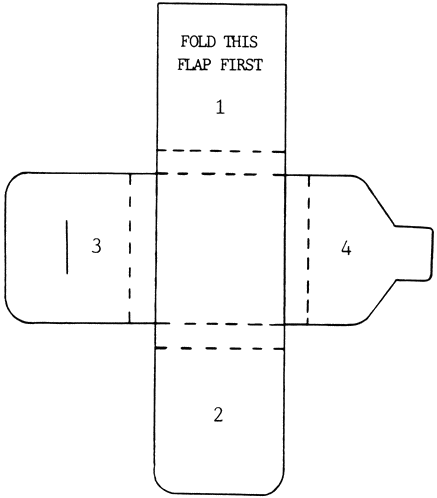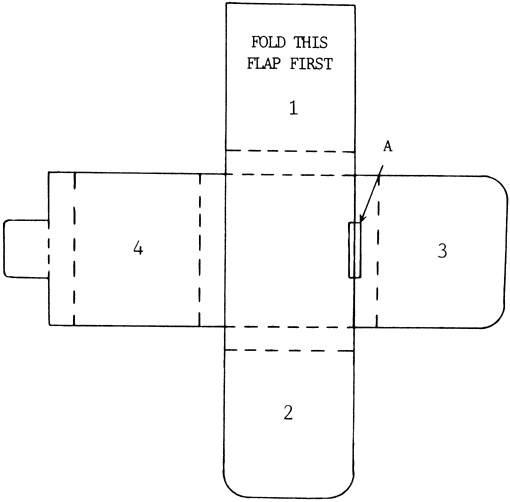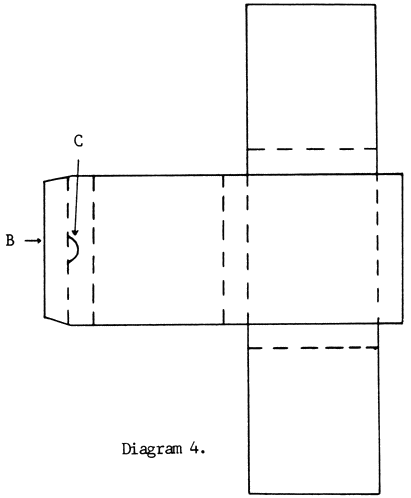

Several months ago, our Conservation Services Division was asked to design a book wrapper for the use of the Princeton University Library. An enclosure similar to a phase box in function and purpose was needed but at a lower cost, both in time and materials.
Our first design was nothing more than two pieces of acid-free map folder stock, one wrapped around the book horizontally and the other vertically. A ribbon was then tied around the wrapped book. It took about five minutes to design and make this wrapper. While it served the purpose, there was obvious room for improvement. Despite the simplicity of a book wrapper, careful design is important. In our case, it is conceivable that several thousand volumes could receive hook wrappers over a period of years. A design flaw at the outset could cause a considerable problem later.
We decided to invest some time and effort, in hope of coming up with a design best suited to our needs. The result has been experimentation over a period of several months with our own and other people's designs. We contacted 10 other large library conservation departments around the country1 Some did not use a book wrapper, others had their own or burrowed designs. In addition, a number of books from our Conservation Reference Library were consulted in search of other design ideas.
Choosing a design (or devising your own) should be done on an individual basis, after assessing the goals and limitations of a particular situation. Some factors to be considered are:
In what type of collection will the wrappers be located, and who will use then? If housed in a restricted area, where perhaps only librarians or pages will be handling then, a more complicated design may be used. If the wrappers will be handled by a wider variety of users, greater emphasis must be placed on simplicity. Try to predict what portion of the users will be seeing a hook wrapper for the first tine. Stopping to tie ribbons or decide in what order flaps should be closed may be confusing and appear unimportant, and therefore ignored. A book wrapper should be designed to meet the user's needs, as well as those of the object.
Who will make the wrapper? Trained personnel, in addition to working more quickly and producing higher quality work, will be better able to handle a more complicated design. If on the other hand, the work is to be done by a librarian or library assistant, for instance, in addition to their other responsibilities, simplicity again should be stressed.
How much does the wrapper cost, and what financial resources are available? How much time is available? How many wrappers are needed? If money or time is especially tight, and a large number of wrappers are needed, a design may be selected that is less time-consuming, uses less material, or uses a less expensive material.
How much use will the wrapper get? for heavy use items, a particularly sturdy design, with perhaps a heavier material, may be chosen. (Beyond a certain point, a phase box rather than a book wrapper should be considered.)
In the Princeton University Library, book wrappers are intended for low use items housed in the Annex Library. The stacks in the Annex are closed. Therefore the library user most request books which are retrieved by staff. Thus, generally only library staff are handling the book wrappers.
The vast majority of the wrappers are now made by trained assistants in Conservation Services. Our first design, however, was intended to be made by Annex staff, and for this reason the design was as simple as possible, requiring no measuring and a minimum number of tools.
Construction of book wrappers at Princeton is an ongoing project, with no deadline and no set number of wrappers to be made. Because the materials to be housed in the wrappers are low-use items, and because of the overwhelming amount of work waiting to be attended to by the Conservation staff, plus our limited budget, we have designed our book wrappers to be inexpensive and easy to make.
In the actual design of the wrapper, a number of points should be considered. It may not be realistic or possible to follow all of these suggestions, but again the circumstances must be taken into account.
From the fifteen or so wrappers we have reviewed, the most useful designs have been selected to discuss and illustrate here.
There are two very good designs that will not be gone into at length, because the information is available elsewhere: Hedi Kyle's "Self Closing Book Wrapper"3 and WilIman Spawn's "Storage Folder." 4
At Princeton, we presently use the wrapper shown in Diagram 1. It is a two-piece wrapper, with the vertical glued on top of the horizontal. The closure is formed by a tongue (flap #4), which fits into a slit in flap #3.

Diagram 1.
We currently use rubber stamps and manuscript marking ink (available from the Library of Congress) to indicate in what order the flaps should be closed. All corners are rounded, with the exception of those on flap #1. These corners are left square to prevent a pressure point.
Our previous design is shown in Diagram 2. It was intended to be made by library staff rather than members of Conservation Services. Instructions were written in such a way as to minimize measuring and tools required. It is a one-piece wrapper, and therefore uses more material and is more time-consuming than our present design. However, the small tongues at the four corners make this wrapper somewhat tighter and more solid.

Diagram 2.
A compromise can easily be reached between these two Princeton designs by making a two-piece wrapper, as in Diagram 1, and including the small tongues at the four corners (as in Diagram 2) on the vertical piece of map folder stock. 5

Diagram 3.
One further Princeton design is shown in Diagram 3. In this two-piece design, the tongue on flap #4 wraps around and is inserted into a cut made in the horizontal piece of stock (A in the diagram). This results in a sturdy, snug wrapper in which the two pieces of stock may or may not be glued together. The closed wrapper holds together very well without adhering. The vertical goes on top of the horizontal. This wrapper is more complicated to make and use than the other designs shown.
The Conservation Department of the University of California at Berkeley has recently designed a wrapper (Diagram 4). This is a two-piece design, with the horizontal glued on top of the vertical. the closure is formed by a flap (B in the diagram) that tucks between the horizontal and vertical pieces. A tab (C in the diagram) is cut with a round chisel and is used for inserting and removing the flap. An effort was made when designing the wrapper to make it impossible to close incorrectly, without the use of instructions. 6

Diagram 4.
All of the wrappers discussed above are excellent designs for particular circumstances. To whatever extent possible, one design should be used consistently. Changing designs causes further confusion among users and staff. In selecting a design, the needs and limitations of each situation must be considered. Certainly there are other book wrapper designs being used that were not discovered in preparing this article. One may wish to experiment by incorporating features from different wrappers into new designs.
11. The conservation departments of the following institutions were contacted: Yale University, New York Public Library, Johns Hopkins University, Newberry Library, Harvard University, University of Michigan, Columbia University, Folger Shakespeare Library, University of California, Southern Illinois University. The responses were as follows: 2 do not presently make book wrappers, 3 have their own design, 2 use a burrowed design, and 3 did not respond.
22. At Princeton, we use a table top Lassco Cornerounder (Model #20), available for approximately $85 from Game Brothers and Lane East Inc., 37 Orchard St., Ramsey, NJ, 07446. A round chisel and hammer can also be used.
33. Kyle, Hedi. Library Materials Preservation Manual. Bronxville, New York: Nicholas T. Smith, 1983. Instructions for the self-closing wrapper begin on page 97.
44. Spawn, Willman. "Physical Care of Books and Manuscripts." Book Collecting, a Modern Guide. Jean Peters, ed. New York: Bowker, 1977. Please note that Mr. Spawn's wrapper was originally intended as a one-piece design. However, when faced with a very large project, he later began producing it as a two-piece wrapper to save on time and materials.
55. Written instructions for the wrappers in Diagrams 1 and 2 are available from Richard Frieder, Conservation Officer, Northwestern University Library, Evanston, IL 60201.
66. Questions concerning the Berkeley wrapper may be directed to Mr. Barclay Ogden, Head of Conservation, 416 Main Library, University of California, Berkeley, CA 94720.